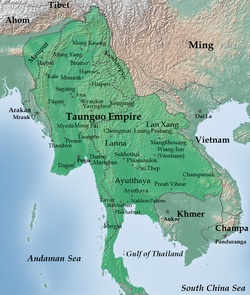Taungoo Empire
| First Toungoo Empire | ||||||||||||||||||||||||||||
| တောင်ငူခေတ် | ||||||||||||||||||||||||||||
|
||||||||||||||||||||||||||||
|
Toungoo Empire at its greatest extent (1580)
|
||||||||||||||||||||||||||||
| Capital |
Toungoo (Taungoo) (1510–39) Pegu (Bago) (1539–99) |
|||||||||||||||||||||||||||
| Languages | Official Burmese |
|||||||||||||||||||||||||||
| Religion | Official Theravada Buddhism Minority
|
|||||||||||||||||||||||||||
| Government | Monarchy | |||||||||||||||||||||||||||
| King | ||||||||||||||||||||||||||||
| • | 1510–30 | Mingyi Nyo | ||||||||||||||||||||||||||
| • | 1530–50 | Tabinshwehti | ||||||||||||||||||||||||||
| • | 1550–81 | Bayinnaung | ||||||||||||||||||||||||||
| • | 1581–99 | Nanda Bayin | ||||||||||||||||||||||||||
| Legislature | Hluttaw | |||||||||||||||||||||||||||
| History | ||||||||||||||||||||||||||||
| • | Toungoo Dynasty founded | 1485 | ||||||||||||||||||||||||||
| • | Independence from Ava | 16 October 1510 | ||||||||||||||||||||||||||
| • | Rise | 1534–49 | ||||||||||||||||||||||||||
| • | Expansion | 1550–65 | ||||||||||||||||||||||||||
| • | Defense | 1568–76 | ||||||||||||||||||||||||||
| • | Decline | 1584–99 | ||||||||||||||||||||||||||
| • | Fall of Pegu | 19 December 1599 | ||||||||||||||||||||||||||
| Area | ||||||||||||||||||||||||||||
| • | 1580 | 1,550,000 km2 (600,000 sq mi) | ||||||||||||||||||||||||||
| Population | ||||||||||||||||||||||||||||
| • | 1580 est. | 6,000,000 | ||||||||||||||||||||||||||
| Density | 4/km2 (10/sq mi) | |||||||||||||||||||||||||||
| Currency | ganza kyat and silver kyat | |||||||||||||||||||||||||||
|
||||||||||||||||||||||||||||
| Today part of | ||||||||||||||||||||||||||||
The First Toungoo Empire (Burmese: တောင်ငူ ခေတ်, [tàʊɴŋù kʰɪʔ]; also known as the First Toungoo Dynasty, the Second Burmese Empire or simply the Toungoo Empire) was the dominant power in mainland Southeast Asia in the second half of the 16th century. At its peak, Toungoo "exercised suzerainty from Manipur to the Cambodian marches and from the borders of Arakan to Yunnan" and was "probably the largest empire in the history of Southeast Asia." The "most adventurous and militarily successful" dynasty in Burmese history was also the "shortest-lived."
The empire grew out of the principality of Toungoo, a minor vassal state of Ava until 1510. The landlocked petty state began its rise in the 1530s under Tabinshwehti who went on to found the largest polity in Myanmar since the Pagan Empire by 1550. His more celebrated successor Bayinnaung then greatly expanded the empire, conquering much of mainland Southeast Asia by 1565. He spent the next decade keeping the empire intact, putting down rebellions in Siam, Lan Xang and the northernmost Shan states. From 1576 onwards, he declared a large sphere of influence in westerly lands—trans-Manipur states, Arakan and Ceylon. The empire, held together by patron-client relationships, declined soon after his death in 1581. His successor Nanda never gained the full support of the vassal rulers, and presided over the empire's precipitous collapse in the next 18 years.
...
Wikipedia

